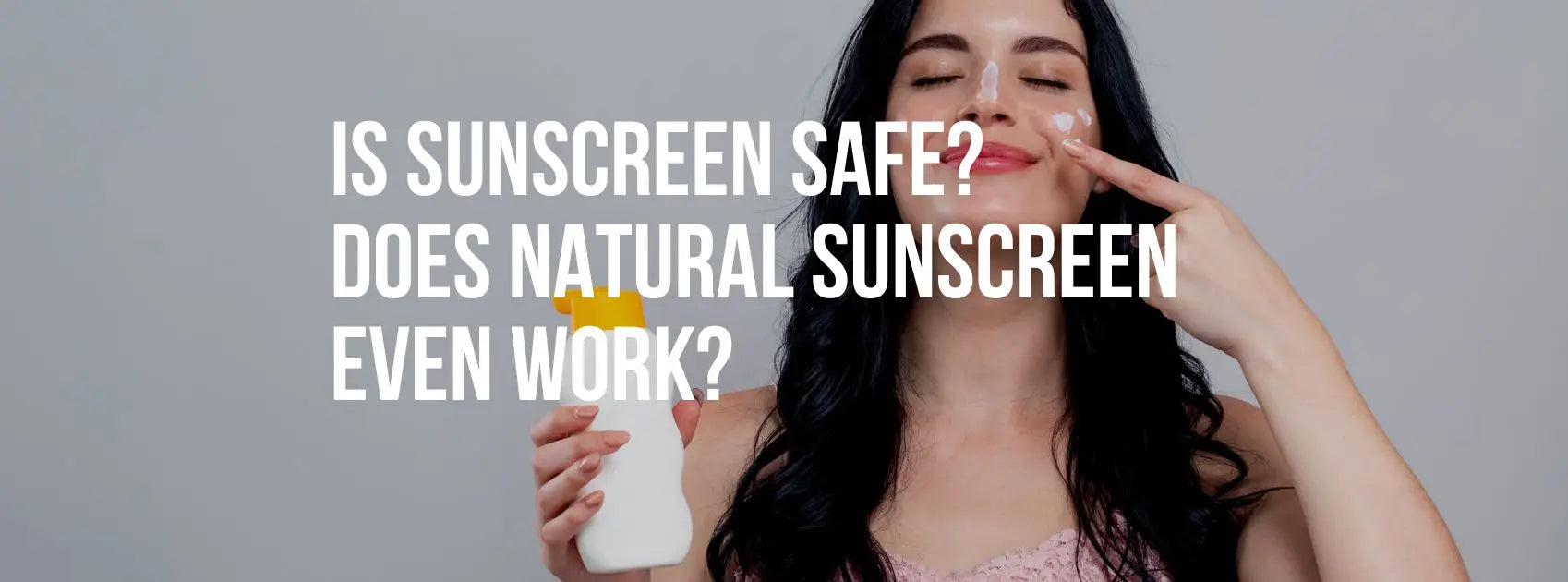
Is Sunscreen Safe? Does Natural Sunscreen Even Work?
Sunlight can improve your health significantly. It increases your vitamin D levels and boosts your mood. But unprotected sun exposure can be damaging to your health. Harmful ultraviolet (UV) rays cause problems like sunburn, premature aging, skin cancer, and eye damage. So, the necessity for protected sun exposure is unquestionable.
Sunscreen is usually our main protection, but did you ever question how safe it is? It is not news that most skincare products have chemicals in them, that can be harmful to ourselves and the environment. This guide will break down some related questions and give you information on how safe or harmful sunscreen is, and alternatives that can protect you from the dangers of the sun.

How does sunscreen impact the environment?
A lot of skincare products, including sunscreen, hurt the environment. Thousands of products use chemicals to protect against ultraviolet rays that are harmful to corals and other marine life.
These chemicals can easily enter the environment because when you apply sunscreen, it doesn’t actually remain on your skin. Instead, it gets washed off when you swim and gets absorbed by corals. If you don’t swim, it can go down drains when you shower. That is how it enters our waterways.
Coral ecosystems around the world have been facing serious threats from climate change, unsustainable fishing, land-based pollution, coastal development, disease, and invasive species. This is extremely concerning as healthy coral reefs are some of the most valuable ecosystems on Earth. They provide billions of dollars in economic and environmental services, like food, coastal protection, and tourism.
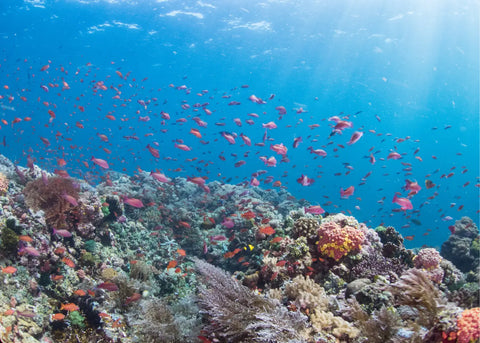
Sunscreen, specifically its chemicals, are part of the threat. Studies show that 14,000 tons of sunscreen are thought to wash into the oceans each year; 82,000 chemicals from personal-care products are tainting the seas; about 80 percent of corals in the Caribbean have been lost in the last 50 years due to pollution, coastal development, and warming waters.
Harmful sunscreen ingredients include chemicals like Oxybenzone, Benzophenone-1, Benzophenone-8, OD-PABA, 4-Methylbenzylidene camphor, 3-Benzylidene camphor, nano-Titanium dioxide, nano-Zinc oxide, Octinoxate, Octocrylene.
Oxybenzone may be the most harmful and unfortunately, is a common ingredient in over 3,500 sunscreen lotions and personal care products. Studies on how poisonous it can be to reefs have found that it contributes to bleaching, has a similar effect to gasoline, and disrupts reproduction and growth, leaving the young coral reefs deformed. The chemical even reduces their resilience to climate change.
Scientists have been concerned about the toxic impacts on marine life for years, and more research continues to emerge. In fact, measures have been taken by local authorities and environmental groups and a few states have enacted sunscreen bans, including Hawaii, Florida, and Palau. From 2020, reef-toxic sunscreens in Palau have been confiscated from tourists, and the merchants selling these can be fined up to $1000. Unfortunately, there is not yet enough research and knowledge to allow government legislation to take action.
Some more ways that these chemicals can affect marine life are:
- Green Algae: their growth and photosynthesis can be impaired.
- Coral: the chemicals can induce bleaching, damage DNA, deform young, and even kill.
- Mussels: can cause defects in the young.
- Sea Urchins: the chemicals can damage their immune and reproductive systems, and deform the young.
- Fish: their fertility and reproduction decrease and male fish can get female characteristics.
- Dolphins: can accumulate in the tissue and be transferred to the young.
Is sunscreen damaging to our health?
Sunscreen’s toxic ingredients may be harmful to us humans as well. Sunscreen provides us with UV protection and prevents us from getting sunburnt, but it may contain several ingredients that are worth questioning. The only sunscreen ingredients that the FDA classified as safe and effective are zinc oxide and titanium dioxide. The agency has even proposed that a few ingredients need additional data from safe and efficacy testing, as new studies have raised concerns about their endocrine-disrupting effects.
According to the FDA, the ingredients oxybenzone, octinoxate, octisalate, octocrylene, homosalate, and avobenzone are readily absorbed into the body after one use and could even be found on the skin and in the blood weeks after no longer being used. Previous studies have detected many sunscreen ingredients in breast milk and urine samples.
Concerns over the constant exposure to sunscreen chemicals have been raised, especially because of the lack of safety data for most ingredients. Some of them are:
- Oxybenzone: It causes allergic skin reactions, behaves as an endocrine disruptor in many studies, and is potentially more harmful to children. The European Commission found the current human exposure levels to this chemical to be unsafe and suggested a concentration restriction of 2.2%, which is lower than the limited amount allowed in the United States (6%). The Environmental Working Group recommends that consumers avoid sunscreen with this ingredient. Be aware that you can find this ingredient in other products such as plastic, hairspray, and nail polish.
- Octinoxate: It is an organic UV filter. According to the Environmental Working Group’s Guide to Sunscreen, which rates the hazards and efficacy of sunscreens, animal studies have shown that it has hormone effects on the metabolic system and affects thyroid hormone production. It can also cause allergic reactions after UV light exposure.
- Homosalate: It has been found to penetrate the skin and disrupt hormones. The European Commission has found that homosalate was not safe to use at concentrations up to 10% and recommends a maximum of 1.4%. The FDA allows a sunscreen concentration of up to 15% in the US.
BM39 is best used for mastocytosis (numerous, itchy, irregular, yellow or orange-brown swelling on the skin); allergy from food (milk, eggs, shellfish or nuts); and medicine allergy.
How can you protect yourself and the environment?
It remains important to consider sunscreen without chemicals that can harm marine life and alternatives that can also protect yourself. Tips to consider:
1. Read the ingredients. Before you buy any sunscreen, check the ingredients. Avoid buying any that contains oxybenzone. Instead, choose mineral-based sunblocks that contain ingredients such as zinc oxide or titanium dioxide.
2. Choose lotion instead of spray. Sprays are obviously convenient, but many of their content misses our bodies and lands on the sand, which subsequently ends up in the ocean.
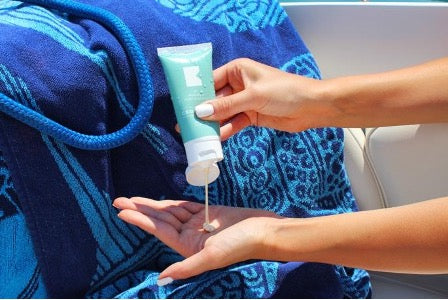
3. Wear UV-protected clothing. Wearing this can reduce the amount of sunscreen you apply by 90%, and it is an optimal sun protection alternative. If you put on a long sleeve shirt during the peak UV of the day, you don’t need to put sunscreen on that part of the body. This helps reduce more than 50% of sunscreen pollution. The Skin Cancer Foundation (SCF) requires a minimum ultraviolet protection violet (UPF) of 30 for effective sun protection. However, even if your clothes don’t have an SCF recommendation, there are other factors, such as color, material, and fit that can help you choose protective clothing. Darker colors like blue or red are better at blocking the sun than lighter colors, as they absorb more UV rays; Considering the material, if you can see through the fabric, it is most likely not protective enough. Clothes made of denim, wool, or polyester don’t let as much UV light in as unbleached cotton or mesh; Looser-fitting clothes can offer more protection from the sun’s rays. This is because tight clothes might stretch or tear, allowing more UV rays to reach your skin.

4. Seek shade between the hours of 10 am and 2 pm. Pick shady spots when you are outside or bring an umbrella or a beach tent to create your shade at the beach. Umbrellas can stop direct UV rays from hitting your skin, but they don’t block scattered or diffused UV rays, which can happen frequently at the beach. So, you must use it in combination with other sun-protecting strategies, like protective clothing.

5. Wear sunglasses. By wearing sunglasses, you can shield your eyes, eyelids, and the sensitive skin around them, and reduce the risk of conditions like cataracts. Studies suggest that large sunglasses may be more effective at protecting your eyes from UV rays than smaller ones. You can check the effectiveness of your sunglasses with the eye-sun protection factor (ESPF) – which measures how well lenses block the transmission of light and UV reflection. The American Academy of Ophthalmology recommends wearing sunglasses that block 99% to 100% of all types of UV light.

6. Check the following lists. Haereticus Environmental Lab provides a list each year of sunscreens that are safe for the environment. Also, the Environmental Working Group rates products with SPF values on their environmental impact.
7. Eat foods that provide sun protection. A healthy diet, specifically rich in antioxidants and omega-3 fatty acids, is crucial to keeping your skin healthy. Many foods contain antioxidants that can help prevent cellular damage. Some examples are vitamin C (oranges, grapefruits, red peppers, broccoli, and tomatoes), vitamin E (wheat germ oil, almonds, and sunflower seeds), carotenoids (bell peppers, cantaloupe, mangoes, and sweet potatoes), niacin (chicken breast, salmon, brown rice, and peanuts), and folate (beef, liver, spinach, and brussels sprouts). Additionally, examples of omega-3-rich foods include fish, such as salmon and sardines, flaxseed and flaxseed oil, walnuts, canola oil, and some fortified foods like cereals and some types of bread (whole wheat bread for instance).

By following these tips you can protect yourself and marine life.
BM254 may help with sunstroke, nausea, heart palpitations, a high body temperature, dry skin, loss of consciousness, dizziness, vomiting, headache, and fatigue. Specially formulated to help normalize body temperature.
Is homemade sunscreen safe?
We use sunscreen to protect ourselves from the damaging effects of sun exposure.
However, for reasons of their harmful effects, cost, and convenience you may consider making your sunscreen from scratch.
But first, you need to understand how difficult it is to make your own effective sunscreen.
To understand what makes sunscreen effective, you must also be aware of some of the terms used to describe it. Let’s start with:
- SPF level. It stands for “sun protection factor”. It is usually represented by a number that estimates how well the product protects your skin from ultraviolet B (UVB) rays. The American Academy of Dermatologists recommends using an SPF of at least 30.
- Broad spectrum. This one protects your skin from not only the sun’s UVB rays but also ultraviolet A (UVA) rays. Although UVB rays are most frequently linked to causing skin cancer, UVA rays can still damage your skin and accelerate wrinkles. So, a broad-spectrum sunscreen offers you more protection.
- This one is used to describe products that can protect you from UV rays by sitting on top of your skin, instead of being absorbed.
- Chemical sun protection filters. In the United States, the Food and Drug Administration (FDA) must approve and regulate sunscreen products. So, most sunscreen ingredients also need to be approved as safe and efficient before you can purchase them. However, as mentioned above, some of the sunscreen ingredients have come under scrutiny for accelerating skin damage and possibly contributing to cancer risk.
- Natural sunscreen. These are commonly associated with products and ingredients that don’t contain a chemical sun protection filter. They are typically free of parabens, oxybenzone, avobenzone, octisalate, octocrylene, homosalate, and octinoxate. Their active ingredients usually come from plants to coat the skin and reflect UV rays off your skin. These ingredients are frequently made of minerals, such as titanium dioxide or zinc oxide, as opposed to chemicals.
To be effective, sunscreen must protect your skin from harmful UVA and UVB rays. The mechanism consists of the sunscreen firstly reflecting or scattering the rays, and then absorbing their energy and distributing it over your skin in the form of heat. Hopefully, you can now better understand what makes sunscreen effective.
Homemade sunscreen is becoming an option for many people. However, before making and using it, you should consider a few things. The FDA has updated its requirements for sunscreen products. These must include titanium dioxide or zinc code to be considered generally recognized as safe and effective (GRASE).
The problem is that if you make sunscreen out of plant-based ingredients like red raspberry seed oil, they may protect you from some UV rays, but they don’t contain a powerful UV filter. Without titanium dioxide, zinc code, or another chemical ingredient that is proven to reflect UV rays, no homemade sunscreen will protect your skin.
Healthline has provided a list of DIY sunscreen recipes that appear the most likely to be effective.
Nevertheless, there is not much research supporting the idea of homemade sunscreen. It takes teams of chemists years to create and perfect a sunscreen formula that the FDA finds safe and acceptable. Don’t forget that it is difficult for anyone without a chemistry degree or pharmaceutical background to calculate the quantity of zinc oxide or titanium dioxide required for adequate sun protection.
So, homemade sunscreen products are risky as they are not tested for efficacy like commercial sunscreen. Of course, commercial sunscreen is also what contains all those questionable ingredients that studies have shown are SO BAD for us!
DIY skincare recipes
Now that you may be considering going for natural alternatives, if you also want to go all-natural on some other skin care products, the video below will give you access to recipes for natural body scrubs, face masks, shampoo, and more.
The bottom line
Sunscreen is an easy way to protect ourselves against the sun. However, the damage it may cause to us and the environment makes it worth questioning it and going for other safer sun-protecting strategies. Help make a positive impact and consider the alternatives.

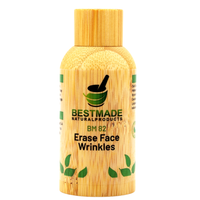
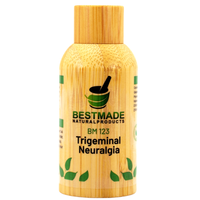
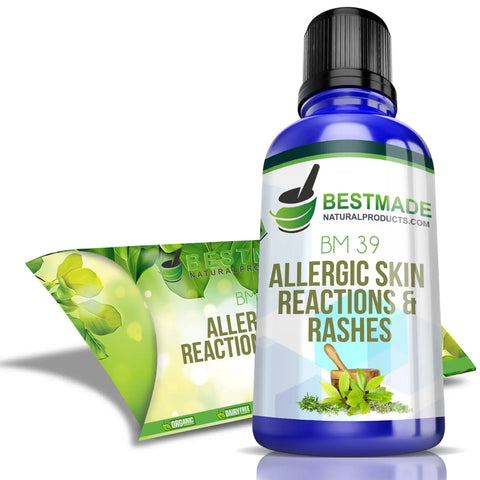
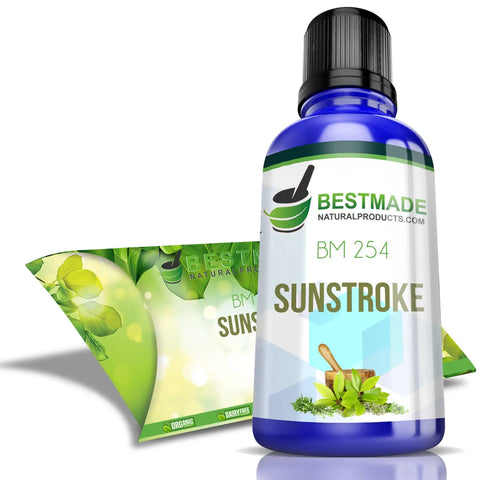
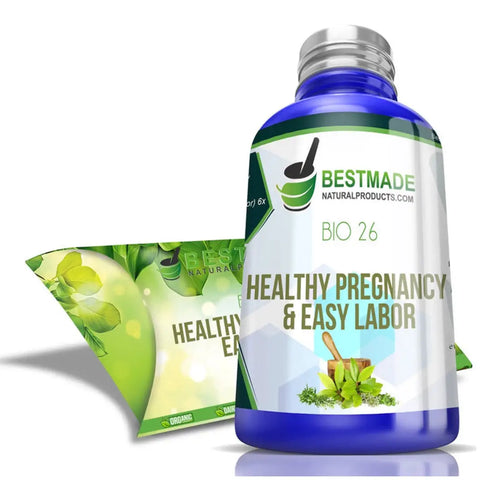
Laissez un commentaire